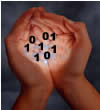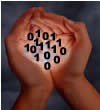

|
How Do CPUs Continue to Increase in Power?
There are several ways that CPU chips produced by the computer industry continue to increase in power. Here are some of the principal factors:
Clock Speed
 A
microprocessor is, as we have learned, a set of flipping switches called
transistors.
A
microprocessor is, as we have learned, a set of flipping switches called
transistors.
Binary digits flow down a set of wires to the CPU. This set of wires is called a bus.
Each bus wire can "carry" a single "bit"—i.e., a single 0 or 1. Here's how: If the voltage on a particular wire is higher than a certain level, it is interpreted as a 1. If the voltage on a wire is lower than a defined threshold, it is interpreted as a 0.
When these voltages flowing down the bus wires arrive at the CPU, they contact the first "line" of the millions of on/off switches (transistors) that make up the CPU chip. The voltage may flip the particular switch it contacts, or it may leave it unchanged. For example:
- If a 0 (low) voltage contacts a switch that is in its off (0) state, then the switch stays in the off (0) state. Why? Because on=1 and off=0, and the machine is built according to the rules of arithmetic, which decrees that 0 + 0 = 0 .
- On the other hand, if a 1 (high) voltage contacts a switch that is in its off (0) state, then the switch changes to the on (1) state. Why? Again, because the machine is built accoding to the rules of arithmetic, and 1 + 0 = 1 .
Once a switch is flipped, it may cause another switch to flip, which could cause other switches to flip, and so on. When this chain reaction of all the switches is complete, we say that the CPU has finished "processing" that instruction. Moreover, we say that the final positions of of the last "row" of on/off switches can be interpreted as a binary representation of a number—a number that we say is the output resulting from the CPU's processing. These output 0s and 1s flow (in the form of voltages) down the bus wires to the particular component of the computer system that is awaiting this result from the CPU.
 Click
image to see an animation illustrating this.
Click
image to see an animation illustrating this.
Thus, one way to make a CPU chip more powerful is to increase the clock speed—that is, to reduce the amount of time it takes to complete this chain reaction of flipping switches (transistors). The speed at which the CPU's switches can complete the chain reactionis measured in hertz—i.e., cycles per second.
One megahertz
means one million cycles per second.
One gigahertz
means one billion cycles per second.
Thus, a 2-gigahertz
microprocessor is working faster than a 1 gigahertz microprocessor.
 A
good analogy, here, is a toll booth: if you can shorten
the amount of time it takes to process one car, more cars can get through
in an hour.
A
good analogy, here, is a toll booth: if you can shorten
the amount of time it takes to process one car, more cars can get through
in an hour.
Number of
Bits

![]() Another
way to make a processor more powerful is to have it grab bigger "handfuls"
of 0s and 1s with every cycle.
Another
way to make a processor more powerful is to have it grab bigger "handfuls"
of 0s and 1s with every cycle.
Early processors were only 8-bit processors, meaning that during each cycle the processor took in eight 0s and 1s and produced eight 0s and 1s as a result.
 In
time, 16-bit processors were developed, thereby doubling
the number of bits that could be handled with each instruction. Thus,
if an 8-bit processor and a 16-bit processor were operating at the same
speed (e.g., 100 megahertz), the 16-bit processor would still accomplish
more than the 8-bit processor, because even though they grab the same
number of handfuls per second, the 16-bit processor grabs handfuls that
are twice as large as what the 8-bit processor grabs.
In
time, 16-bit processors were developed, thereby doubling
the number of bits that could be handled with each instruction. Thus,
if an 8-bit processor and a 16-bit processor were operating at the same
speed (e.g., 100 megahertz), the 16-bit processor would still accomplish
more than the 8-bit processor, because even though they grab the same
number of handfuls per second, the 16-bit processor grabs handfuls that
are twice as large as what the 8-bit processor grabs.
In terms of our toll booth analogy, this is like opening additional lanes at the toll gate. The more cars that can be handled simultaneously, the more cars get through in an hour.
Today, CPUs are typically 32-, 64-, or 128-bit processors.
Parallel
Processing
Another way to give a computer more processing power is to give it more
than one microprocessor. This is called "parallel processing"
or "parallel computing." Today's supercomputers,
in fact, are comprised of tens of thousands of microprocessors. (Thus,
they are said to be "massively parallel processing computers.")
(Click here to read about Calvin's supercomputer)
Because the microprocessor as always been the most expensive part of a personal computer, it has not been feasible until recently for a personal computer to have more than one microprocessor in it. However, high-end personal computers now contain multiple processors, and this is likely to become more common in the years ahead.
![]()
![]()
These pages were written by Steven H. VanderLeest and Jeffrey Nyhoff and edited by Nancy Zylstra
©2005 Calvin University (formerly Calvin College), All Rights Reserved
If you encounter technical errors, contact computing@calvin.edu.